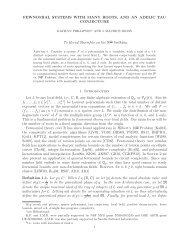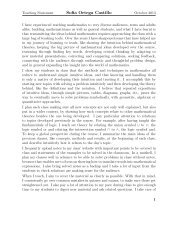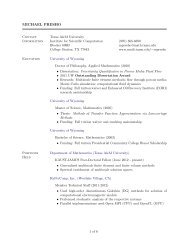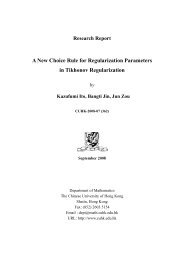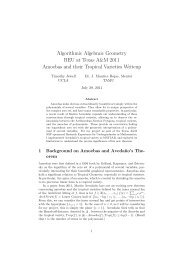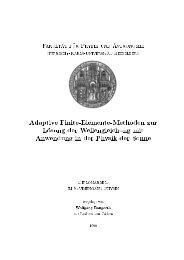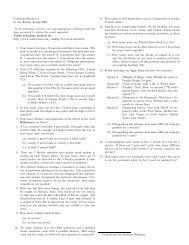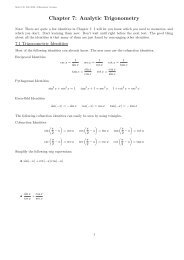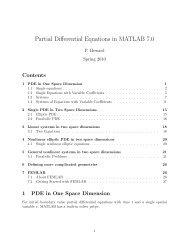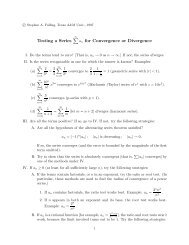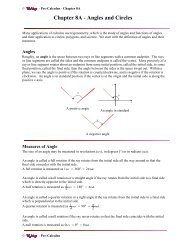Tensors: Geometry and Applications J.M. Landsberg - Texas A&M ...
Tensors: Geometry and Applications J.M. Landsberg - Texas A&M ...
Tensors: Geometry and Applications J.M. Landsberg - Texas A&M ...
Create successful ePaper yourself
Turn your PDF publications into a flip-book with our unique Google optimized e-Paper software.
4 1. Introduction<br />
data into a “multi-way array” <strong>and</strong> isolate essential features of the data by<br />
decomposing the corresponding tensor into a sum of rank one tensors. Chapter<br />
12 discusses several examples of tensor decomposition arising in wireless<br />
communication. In §1.3, I provide two examples of tensor decomposition:<br />
flourescence spectroscopy in chemistry, <strong>and</strong> blind source separation. Blind<br />
source separation (BSS) was proposed in 1982 as a way to study how, in<br />
vertebrates, the brain detects motion from electrical signals sent by tendons<br />
(see [95, p. 3]). Since then numerous researchers have applied BSS in<br />
many fields, in particular engineers in signal processing. A key ingredient of<br />
BSS comes from statistics, the cumulants defined in §12.1 <strong>and</strong> also discussed<br />
briefly in §1.3. P. Comon utilized cumulants in [93], initiating independent<br />
component analysis (ICA), which has led to an explosion of research in signal<br />
processing.<br />
In a letter addressed to von Neumann from 1956, see [289, Appendix],<br />
Gödel attempted to describe the apparent difference between intuition <strong>and</strong><br />
systematic problem solving. His ideas, <strong>and</strong> those of others at the time,<br />
evolved to become the complexity classes NP (modeling intuition, or theorem<br />
proving) <strong>and</strong> P (modeling problems that could be solved systematically<br />
in a reasonable amount of time, like proof checking). See Chapter 14 for<br />
a brief history <strong>and</strong> explanation of these classes. Determining if these two<br />
classes are indeed distinct has been considered a central question in theoretical<br />
computer science since the 1970’s. It is now also considered a central<br />
question in mathematics. I discuss several mathematical aspects of this<br />
problem in Chapter 13. In §1.4, I briefly discuss an algebraic variant due to<br />
L. Valiant: determine whether or not the permanent of a matrix of size m<br />
can be computed as the determinant of a matrix of size m c for some constant<br />
c. (It is known that a determinant of size on the order of m 2 2 m will work,<br />
see Chapter 13.)<br />
A new approach to statistics via algebraic geometry has been proposed<br />
in the past 10 years. This algebraic statistics [261, 257] associates geometric<br />
objects (algebraic varieties) to sets of tables having specified statistical<br />
attributes. In a similar vein, since the 1980’s, in physics, especially quantum<br />
information theory, geometric subsets of the Hilbert space describing<br />
all possible quantum states of a crystal lattice have been studied. These<br />
subsets are meant to model the states that are physically reasonable. These<br />
so-called tensor network states go under many names in the literature (see<br />
§1.5.2) <strong>and</strong> have surprising connections to both algebraic statistics <strong>and</strong> complexity<br />
theory. Chapter 14 discusses these two topics in detail. They are<br />
introduced briefly in §1.5.<br />
The purpose of this chapter is to introduce the reader to the problems<br />
mentioned above <strong>and</strong> to motivate the study of the geometry of tensors that



